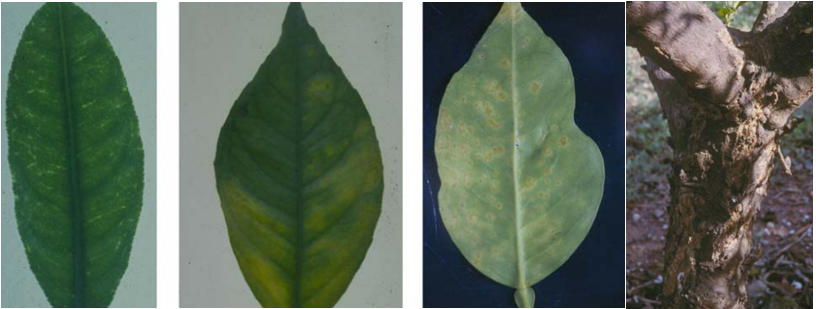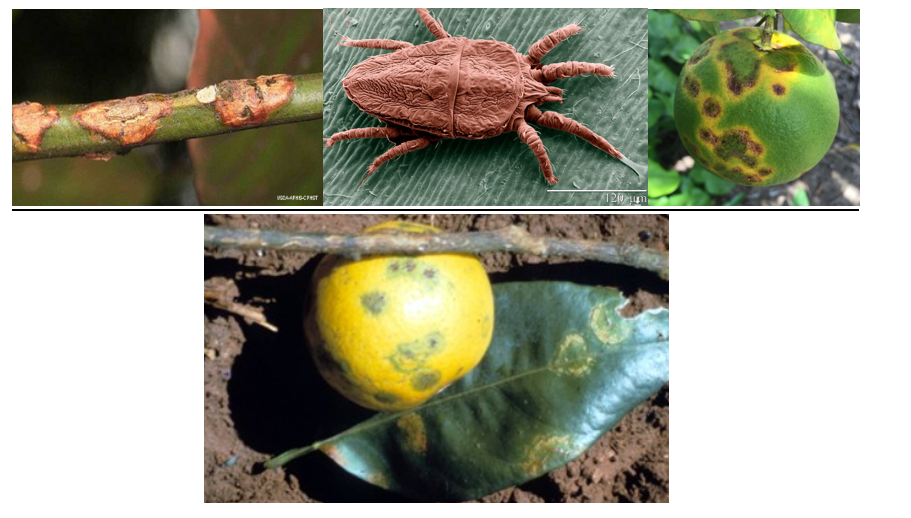Important Virus Diseases in Citrus trees
What are the most important viral diseases that affect citrus trees?
1. Tristeza
How does the tristeza virus affect citrus trees?
Citrus Tristeza Virus (CTV) is a phloem-limited virus that belongs to the Closteroviridae family. It infects all citrus species, hybrids and cultivars, and other closely related Citrus and Fortunella genera of the Rutaceae family.
CTV is considered the most important viral disease of citrus worldwide. Symptoms of CTV depend on environmental conditions, rootstock, and virus strain; and include overall tree decline, stem-pitting, and yellow stains on seedlings.
Infection usually results in quick decline, wilting, and death of the tree. Once the infection has occurred, the phloem vessels (the ones that carry nutrients) become dysfunctional leading to girdling at the bud union, a reduction of the root system, dull-green to yellow foliage, leaf drop, twig die-back, and the production of low quality, unmarketable pale fruits. Symptoms also include stunting and small yellow leaves in grapefruit and sour orange. In extreme cases, there is a distribution of deep pits, longitudinal depression in the bark, distortion, and twisting of the main branches, and the development of many fine pits.
Citrus Tristeza Virus
Most CTV introductions in a country arise from propagating virus-infected planting materials. Contrastingly, local virus dispersal is due to vector transmission.
Seven aphid species are considered CTV vectors:
- Aphis gossypii
- Aphis spiraecola
- Aphis craccivora
- Toxoptera aurantia
- Myzus persicae
- Macrosiphum euphorbiae
- Toxoptera citricida
Other factors affecting the rate of CTV spread include aphid population density, environmental conditions such as moderate temperatures, irrigation, and nitrogen fertilization that results in new foliage flushes. CTV is responsible for the death of over 50 million trees, especially in regions where the most susceptible rootstock is used, which is sour orange. This disease is distributed worldwide in tropical citrus-growing areas. Iodine testing on plants for starch depletion and microscopic detection for inclusion bodies have been used for diagnosis. Farmers that cultivate citrus trees could use the above description of the symptoms and the pictures indicated to identify potential Tristeza infections on their trees. Always seek the advice of your local agronomist. The biological control of aphids, virus vectors, is one of the most effective ways to treat the disease.
How to prevent or treat Tristeza (CTV) – infected citrus trees?
- Unfortunately, there is no single effective strategy against CTV
- Virus-free certification programs should be introduced on a local scale for monitoring
- Prohibition of importation of citrus trees from countries with CTV
- Treatment of exported fruits for pests to prevent the introduction in other countries
- Use of biological control of aphid vectors
- Chemical control of aphid vectors
2. Tatter Leaf or Citrange Stunt
What is the Citrus Tatter Leaf Virus, and how does it affect citrus trees?
Citrus Tatter Leaf Virus (CTLV) disease is caused by the Citrus tatter leaf virus. It affects many citrus species, hybrids, and cultivars; however, it remains symptomless in most citrus species, including C. sinensis, C. aurantium, C. paradisi, C. reticulata and C. limon.
Tatterleaf virus is believed to have originated in China and to have been imported into the USA in 1962 in latently infected ‘Meyer lemon’ materials. Since then, it’s been reported in Japan, Africa, and Australia and is restricted to Morocco in the Mediterranean. This disease causes bud-union abnormalities or fluting when these varieties are grafted onto a trifoliate rootstock. Stems of afflicted citrange plants become deformed and exhibit a zig-zag growth pattern in chlorotic regions. Stunting is also observed. Chlorotic spotting and mottling appear on leaves which show deformities or tattered leaves. The spreading of this virus is amplified by mechanical transmission via pruning tools or razor cuts. There is no evidence of invertebrate vectors for this disease. See images for identification. 
Citrus Tatter Leaf Virus
How to treat Tatterleaf (CTLV) – infected citrus trees?
- Combination of thermotherapy and shoot-tip grafting techniques
3. Psorosis
What is the Citrus Psorosis Virus, and how does it affect citrus trees?
Citrus Psorosis Virus (CPsV) is a disease caused by a member of the genus Ophiovirus. Psorosis A is the more common and milder form of the disease compared to Psorosis B, which is the more severe form. The latter strain has been referred to as the Citrus ringspot virus. Symptoms of Psorosis A include bark scaling in mature (over ten years) orange, grapefruit, and mandarin field trees. At a later stage, gumming appears, which leads to its accumulation below the scales, impregnating the xylem (water-carrying vessels), resulting in the staining of the wood of the main trunk and limbs and vessel occlusions. Leaf symptoms such as chlorotic flecking are observed on young leaves on new flushes. Psorosis B symptoms include persistent chlorotic flecking on leaves with gummy pustules on the underside, extensive bark scaling of the trunk and secondary branches, and occasional ringspot blemishes on fruits. Neither strain of the disease kills citrus trees completely. However, infected trees exhibit reduced canopies and twig die-back. Their fruits weigh less than normal. The propagation of infected planting materials mainly spreads psorosis, but observations in Argentina, Texas, and California implicate an unknown vector. 
Citrus Psorosis Virus
How to prevent and treat Psorosis-infected citrus trees?
- Implementation of budwood certification programs on a local scale
- Use of serological methods for diagnosis
- TAS-ELISA & RT-PCR methods for early detection
- Eliminate the virus from propagative materials using shoot-tip grafting, thermotherapy (40°C for 16 hours with light and 30°C for 8 hours in the dark)
4. Leprosis
What is the Leprosis virus, and how does it affect citrus trees?
Citrus leprosis (CL), or scaly bark, is a disease that affects citrus trees, and it is caused by the Citrus leprosis virus (CiLV). The disease is responsible for large economic losses, mostly of orange and mandarin (C. reticulata, C. reshni, C. deliciosa). Symptoms include the appearance of lesions on citrus leaves, stems, and fruits. Lesions 2-3 mm in diameter are initially chlorotic and then become necrotic while maintaining a chlorotic halo. Larger lesions (10-20 mm) form due to the coalescence of smaller leaf lesions. Fruit lesions become depressed and are associated with gum exudation. Stems exhibit protuberant, necrotic lesions. At a later stage, twigs dry up and die.

Leprosis virus in citrus trees
Premature fruit drop is observed, as well as leaf abscission. The Leprosis virus is mostly reported in the Americas; it has not occurred in Europe. The disease usually spreads via vectors. Brevipalpus mites (false spider mites) have been incriminated in vectoring CiLV. Each viral lesion produced is presumably associated with feeding by a mite vector. Close observation and biological control of these mites are considered the most effective ways to treat and prevent the disease at the earlier stage possible.
How to prevent and treat Citrus Leprosis – infected citrus trees?
- Use of resistant citrus cultivars
- Use of windbreaks
- Control of weeds that are reservoirs of vectors such as mites
- Pruning to reduce disease inoculum
- Seasonal acaricide sprays to manage mite populations
- Use of entomopathogenic fungi for biological control of mites
- Use on predaceous mites (Phytoseiidae)
5. Exocortis & Cachexia
What are Exocortis and Cachexia diseases, and how do they affect citrus trees?
Exocortis and Cachexia are viroid diseases caused by Citrus exocortis viroid (CEVd) and Hop stunt viroid (HSVd), respectively. They are pathogenic to all citrus species and varieties but not lethal and cause significant economic losses worldwide. Symptoms of Exocortis include stunting, bark-scaling, and bark-splitting of trees grafted on trifoliate orange, citranges, citron, ‘Palestinian sweet lime,’ and ‘Rangpur lime.’ Losses mainly result from reduced vegetative growth and fruit yield; fruit quality is usually not affected. Tree age and environmental condition determine the severity of the symptoms and the time of symptom expression.
CEV-infected sweet oranges, grapefruit, and mandarin are generally symptomless. However, when grafted on sensitive rootstock, bark-scaling develops on the rootstock, and the tree exhibits stunting.
On the other hand, Cachexia is a gumming and wood-pitting disorder of citrus, similar to Exocortis. Symptoms include pitting and gum impregnation of the phloem (nutrient transport vessels of trees). Over time, infection is characterized by stunting, chlorosis, and eventual death of the tree. The following images represent the disease and can be used for identification. Early identification by regular observation can prevent economic loss.
How to treat Exocortis and Cachexia – infected citrus trees?
- Use of certified budwood
- Clean pruning equipment and budding knives
- Removal of diseased trees
Further reading
Fruit-tree related terminology and categorization – Pomology
The most Popular Lemon Tree Varieties
Lemon Tree Pruning for Optimal Growth and Yield
Nutrient needs and Fertilization of Lemon trees
Important Citrus Diseases caused by Fungi
Important Virus Diseases in Citrus trees
Bacterial Citrus Diseases: Identification and Control
References
- Chagas CM (2000) Leprosis and Zonate Chlorosis. In: Timmer LW, Garnsey SM, Graham JH (Eds) Compendium of Citrus Disease. American Phytopathological Society Press. St. Paul. MN, pp 57-58
- Derrick KS, Barthe GA (2000) Psorosis. In: Timmer LW, Garnsey SM, Graham JH (Eds). Compendium of Citrus Diseases. St. Paul. MN, pp 58-59S
- Fagoaga et al., 2006. Post-transcriptional gene silencing of the p23 silencing suppressor of Citrus tristeza virus confers resistance to the virus in transgenic Mexican lime. Plant Molecular Biology. 60, 153-165
- Gandia et al. 2007, Transcriptional response of Citrus aurantifolia to infection by Citrus tristeza virus. Virology 367, 298 – 306
- Garnsey SM, Gumpf DJ, Roistacher CN, Civerolo E, Lee RF, Yokomi RK, Bar-Joseph M (1987) Toward a standard evaluation of the biological properties of citrus tristeza virus. Phytophylactica 19, 151-157
- Hilf ME (2008) An immunocaptive RT-PCR procedure using Apple stem grooving virus antibodies facilitates analysis of Citrus tatter leaf virus from the original Meyer Lemon host. Plant Disease 92, 746-750
- https://en.wikipedia.org/wiki/Citrus_leprosis_disease
- https://www.cdfa.ca.gov/citrus/pests_diseases/cld.html
- Ohira et al., 1995, Complete sequence of an infectious full-length cDNA clone of citrus tatter leaf capillovirus: comparative sequence analysis of capillovirus genomes. Journal of General Virology 76, 2305- 2309
- Ruiz-Ruiz et al., 2006. The complete nucleotide sequence of a severe stem pitting isolate of Citrus tristeza virus from Spain: comparison with isolates from different origins. Archives Virology 151, 387-398
- Sharma, Priyanka & Roy, Monish & Roy, Bidhan. (2021). A Brief Overview of Major Citrus Diseases and Pests and Its Management. 10.9734/bpi/ctas/v1/13548D.
- Tennant et al., 2009. Global Science Books, Tree and Forestry Science and Biotechnology.









































































